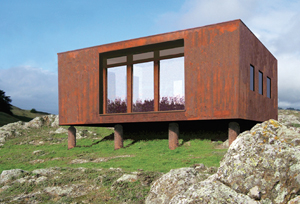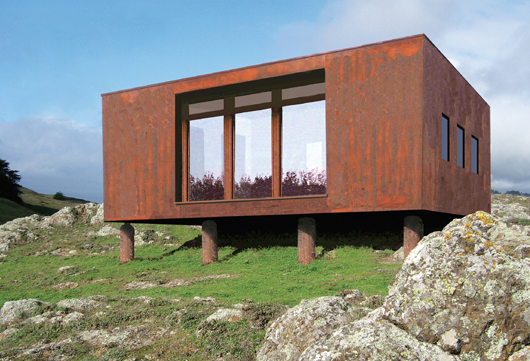
DES MOINES, Iowa (AP) – Sean Spain is selling a house for $10,500, about the price of a used car with a sleepable back seat.
Granted, it’s 100 square feet. But the home is a charming little rebuttal to America’s obsession with big living. The average home square footage in the U.S. continues to climb – 1,525 square feet in 1973 to 2,598 last year – while an underground trend toward “micro” living has emerged, The Des Moines Register reported.
Most people’s master baths are bigger than Spain’s cottage. It sits on an old trailer and is made of reclaimed materials and features a living room, kitchen and sleeping loft all in one room and a tiny toilet closet.
Iowans were at the forefront of the tiny-house trend a dozen years ago, but it has taken off in coastal states, Colorado and among the popular press. Just how many tiny houses of fewer than 300 square feet exist is not known because they’re often out of view on private land or rolled into recreational vehicle parks, too small to meet city zoning and building code requirements.
The small homes hit at a philosophy, which often sounds good on paper but more difficult in reality: Let’s get rid of all this stuff and live simply. The young want them for affordability, the empty nesters because they are tired of tending to large homes filled with rooms they never go in. Others want them because the Earth is warming and the environment matters to them.
Or maybe they just always wanted a fort.
“I have friends in Colorado who told me there is a huge market for these out there,” said Spain, who works in construction.
So at age 52, with his kids grown, he decided it was time to pursue a passion, assembling a work of rustic art making little abodes from materials gathered at auctions, farm yards and garage sales.
Let’s take a home tour. You can stand in one place.
It starts with the trailer, which costs 50 bucks to pull off a farmer’s property. Spain wanted to build the home on a mobile platform, so its 2,900 pounds could be pulled anywhere by a sturdy truck. It currently sits by the Raccoon River on his son’s property in West Des Moines’ Commerce neighborhood.
Its mobility serves a larger purpose. Most cities, including Des Moines, have a building code requirement that adheres to international codes for a dwelling, requiring at least one room with 120 square feet and other rooms not less than 70 square feet. If it’s mobile you don’t need a building permit. Although West Des Moines has no minimum square footage requirements, there are lot-size requirements and zoning regulations that could prohibit it.
Spain envisions a country acreage owner who wants a temporary cabin or getaway as his primary customer, although in some states the tiny homes are serving as year-round residences.
The roof and windows are new to prevent leaks. It’s insulated, and a steel beam structure makes it lightweight so it can be pulled easier. Most of the rest is made of used material that Spain hunted down. The exterior is former cedar deck and tin from an old barn, as is a small front deck on hinges that can be plopped down to enjoy the day or pulled up for transport. A headlight from an antique car lights the entrance and a tractor fender serves as an entry overhang.
Inside the front door made of reclaimed wood and an antique knob from a house in Des Moines, is a warm little room with a vaulted ceiling. The walls are quarter-inch cedar and the cabinets for storage are made of old barn wood. A bench seat with a cushion is what you have to sit on.
There is a counter with a sink along the “far” wall, a space for a tiny propane stove and cubby for a compact refrigerator. On the opposite wall, a custom-made furniture stand can serve as place for electronics or eating or anything you don’t have place for, which may be a bit of everything.
A ladder leads to a loft with just enough clearance to sit up in bed and fit two snugly.
A room smaller than a closet fits the toilet and your legs. Hookups for septic and a breaker box allow you to be on the grid, while a wall-mounted propane heater supplies heat. With today’s compact entertainment options, if you have a tablet you have an entertainment center and a library.
That’s it. 14 feet by 7 feet.
“Some people can live in here,” said Spain, who lives in Johnston. “My tools alone wouldn’t fit.”
The Small House Society was launched in Iowa City. Jay Shafer, a former university art professor, built a 130-square foot home in Iowa City and word got around. By 2002, he joined Greg Johnson and others to form the Small House Society (www.smallhousesociety.net) that fosters the development of smaller, sustainable living spaces.
“There are quite a few in Iowa City,” said Johnson, who works in the University of Iowa’s IT department. “Part of the challenge is to track how popular it is. They are not building these publicly because they are concerned about zoning. But when you put it on wheels it becomes more like an RV and falls under more lenient categories of regulations.”
Some tiny homes are becoming extravagant, well-appointed cottages with French doors and fireplaces.
Johnson lived in what was essentially a sleeping cabin, 10 feet by 7 feet, from 2003 to 2009. “I’d wake up in the morning and go to the gym to take a shower.”
He said people are waking up to the low cost of ownership and upkeep on a tiny house. He’s also talked to plenty of folks who tried to sell a 4,000-square-foot house that sat on the market for two years while smaller homes sold in days.
The micro trend also comes out of fear that the climate is changing and huge investments in a home can be wiped out by volatile weather, he said, or are an answer to affordable housing shortages for the poor.
While Shafer moved to California and owns a company that builds tiny homes, Johnson has stayed in Iowa City, although in a little larger home, because “at some point in life it isn’t practical to live in something the size of a garden shed.”
In fact, some tiny homes are converted garden sheds. The standard building cost of $150 per square foot can be reduced by using old materials or turning a shed into a little home.
“I build anything from an 8 by 8 to a 14 by 24,” said Shawn Van Wyk of Van Wyk Wood Builders in Grinnell, Iowa, which sells storage sheds and little cabins. “They have a front porch on one end. Some will have a loft and others without. They use them for a vacation cabin or others will live in them.”
Spain doesn’t want his homes to look like sheds or a camper. It’s about the creative process, building custom furniture and now homes that inspire him.
“I’ve gone back to the stuff I love,” he said.
That’s no small thing.
Sean Spain is starting to build another tiny house, which will include a shower, and has ideas for others. If you’re interested, contact him at seanfspain@gmail.com
To see more small homes, lists of manufacturers and other tips, go to smallhousesociety.net
___
Information from: The Des Moines Register, http://www.desmoinesregister.com
Copyright 2014 Associated Press. All rights reserved. This material may not be published, broadcast, rewritten, or redistributed.
AP-WF-11-08-14 1602GMT
ADDITIONAL IMAGE OF NOTE



